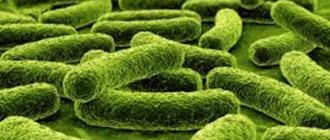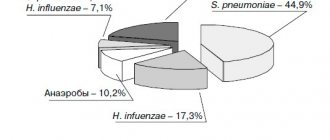Back to list Previous article Next article
03.11.2017
Tags:
pseudomonas, pseudomonas
( 2 ratings, average: 5.00 out of 5)
Discovery History
In 1855, during the Crimean War, the French surgeon S. E. Sedillot discovered that some soldiers had purulent wounds that turned the dressing material an aquamarine color. The same doctor was the first to call living beings invisible to the naked eye microbes. The pigment itself, which is secreted by bacteria during this infection, was discovered in 1860, and in 1862 Luke linked pyocyanin with microorganisms found in wounds. Because of this feature, these bacteria were called Pseudomonas aeruginosa.
Pseudomona saeruginosa (Pseudomonas aeruginosa) is a Gram-negative bacterium that causes disease in humans and animals. It is found in soil, water, and the outer skin of humans. Despite the fact that P.аeruginosa is an obligate (strict) aerobe, it can reproduce in low oxygen conditions, and thus can infect both natural and artificially created environments. For its vital functions it can use a wide range of biological materials. It is one of the main causative agents of purulent-inflammatory processes, especially in a hospital setting. The first description of a wound infection caused by Pseudomonas aeruginosa belongs to Luke (1862), who noted the blue-green coloration of the dressing material. In 1897, the first outbreak of hospital infection caused by P. aeruginosa was officially registered. P. aeruginosa can be present on the skin, nasopharynx and intestines of healthy people (found in approximately 3-5%), without causing disease.
Biological properties
Straight or curved rod with rounded ends 1-5 x 0.5-1.0 microns. Chemoorganoheterotroph, aerobe, facultative anaerobe (denitrifier). It grows on meat-peptone agar, and the medium turns blue-green; on meat-peptone broth, when growing in the medium, turbidity and a film are detected, and a blue-green color is also characteristic. The optimal growth temperature is 370C. Selective medium – nutrient agar with cetylperidinium chloride. Forms proteases. On solid nutrient media it dissociates into three forms - R-, S-. and M-shape. Produces characteristic pigments: pyocyanin (phenazine pigment, which colors the nutrient medium blue-green, extracted with chloroform), pyoverdine (yellow-green pigment that fluoresces in ultraviolet rays) and pyorubin (brown). Some strains carry out biodestruction of hydrocarbons, including formaldehyde
Rice. 1 Pseudomona saeruginosa, nutrient medium.
Rice. 2 . Pseudomonas aeruginosa, microscopy
Rice. 3 . Pseudomonas aeruginosa, electron microscopy
Epidemiology
P.аeruginosa is widespread in nature, soil, water, plants, animals (including humans). Water is of great importance in the circulation of P. aeruginosa, in which it can persist for up to 1 year at a temperature of 37°C, including in many solutions used in medicine (for example, liquid for storing contact lenses). Sometimes it is part of the normal microflora (skin of the groin, axillary area, ears, nose, pharynx, gastrointestinal tract). P. aeruginosa causes up to 10-20% of all hospital-acquired infections, causing infections such as pneumonia, genitourinary infections and bacteremia. It is most often sown in patients who have been in the hospital for more than 7 days.
Properties of the pathogen
Gram-negative rods, motile, have 1-2 polar flagella, are located singly, in pairs, in short chains in the smear, synthesize a starch-like substance such as extracellular mucus, more virulent strains synthesize an increased amount of it. Grows well on simple nutrient media and has limited nutrient requirements. Grows in a wide temperature range (4-42°C). Pronounced chemoorganotroph, strict aerobe, highly proteolytic activity, low saccharolytic activity. Produces bacteriocins - pyocins (proteins that have a bactericidal effect on microorganisms of a similar or genetically similar species). Pigment formation is characteristic. The most common are: pyocyanin (colors the wound discharge medium blue-green), fluorescein (fluoresces under UV irradiation). Some strains can synthesize other pigments. Highly virulent strains synthesize pyocyanin, which has bacteriocin properties, in large quantities. When isolating cultures, atypical non-pigmented strains may be observed.
The pathogenic effect is due to the formation of exotoxins and the release of endotoxins during cell death. It produces the following exotoxins: exotoxin A - causes a disruption in the organization of the protein synthesis matrix, exoenzyme S - causes deep pathological processes in the lungs, cytotoxin - causes neutropenia and cytolysis of other cells, hemolysins, phospholipases. Among the waste products, enterotoxic factor (possibly responsible for the development of diarrhea syndrome), permeability factor, neuraminidase (disturbs the metabolism of neuraminic acid), proteolytic enzymes (proteases, collagenase) are important.
It has somatic O and flagellar H antigens; in mucoid strains the capsular K antigen can be detected.
Pathogenesis of lesions Despite the presence of a large number of virulence factors, infections occur more often in individuals with a defective immune system. Most strains have superficial villi that ensure adhesion to the epithelium. Attachment stimulates the fibronectin deficiency seen in cystic fibrosis and other chronic lung diseases. It is a typical extracellular parasite. The main role in the pathogenesis of lesions is played by toxins of the pathogen.
Clinical manifestations Strictly speaking, P. Aeruginosa is an opportunistic organism for humans. It never affects healthy, undamaged tissue. On the other hand, there are no tissues in the body that, in the event of damage or other reduction in protective functions, could not be attacked by Pseudomonas aeruginosa. Therefore, infections caused by Pseudomonas aeruginosa are quite common hospital-acquired infections. Local infection most often occurs at the site of cuts (including surgical sutures) and burns. Pseudomonas aeruginosa can cause urinary tract infection (introduced, for example, through the insertion of catheters), eye infection (as a result of trauma or surgery), and skin and soft tissue infection (wound infections, dermatitis, pyoderma). Pseudomonas aeruginosa is often detected during examination of children suffering from otitis media - inflammation of the middle ear. Other serious infections caused by Pseudomonas aeruginosa include pneumonia, endocarditis (infection of the heart valves), infections of the central nervous system (meningitis and brain abscess), musculoskeletal system (including joints) and gastrointestinal tract. Pseudomonas aeruginosa is one of the main causative agents of nosocomial pneumonia, lesions of the genitourinary system in urological patients, causing 20-25% of purulent surgical infections. Often found in patients with burns and bladder diseases. Factors of infection with P.аeruginosa: violation of the rules of sterilization, storage and use of vascular and urinary catheters, as well as needles for lumbar puncture, as well as various solutions used in medicine.
Laboratory diagnostics The characteristic coloring of wounds and dressings in a blue-green color allows one to suspect a Pseudomonas aeruginosa infection. To isolate and identify the pathogen, the culture method of sowing is used. The material must be collected before starting antibacterial therapy. Grows on simple nutrient media, particularly Mueller-Hinton agar. When growing on dense media, it produces the characteristic phenomenon of rainbow lysis, which develops spontaneously; when pigment is formed, it colors some media green. The pyocyaninotyping method is used, based on the fact that strains are resistant to their own pyocyanin and have varying sensitivity to pyocyanins of other strains. In liquid media they grow in the form of a surface film; over time, a turbidity forms, spreading from top to bottom.
Drug resistance and treatment of P.aeruginosa-associated infection
P. aeruginosa is resistant to many betalactams, aminoglycosides, cephalosporins, and fluoroquinolones. Infections caused by P. aeruginosa are curable today, despite the fact that they are difficult to treat due to its multiple resistance transmitted by R-plasmids.
Mechanisms of resistance of P. aeruginosa: blocking the transport of the antibiotic to the intracellular target and inactivation by enzymes (beta-lactamases inactivate penicillins and cephalosporins, acetyltransferase and nucleotidase inactivate aminoglycosides). In the NPRS-3 study, Pseudomonas aeruginosa was characterized by a high level of resistance to gentamicin (61.3%), as well as to piperacillin, piperacillin/tazobactam, and ciprofloxacin. The most active against P.aeruginosa were amikacin (resistance 6.7%) and ceftazidime (resistance 11.2%), meropenem (resistance 3%).
Antibacterial therapy of nosocomial infections of established etiology
| Microorganism | Drugs of choice | Alternative drugs | |
| monotherapy | combinations | ||
| P. aeruginosa | Ceftazidime Cefepime Ciprofloxacin | Ceftazidime + aminoglycosides Cefepime + aminoglycosides Ciprofloxacin + aminoglycosides | Antipseudomonas penicillins (except ICU), aztreonam or carbapenems + aminoglycosides |
The average frequency of ceftazidime-resistant strains in ICUs in Russia was 11%; an increase in imipenem- and ciprofloxacin-resistant strains was noted (19% and 30%, respectively)
According to Hachem RY et al. [2] The most effective antibiotics for treating P. aeruginosa are:
aminoglycosides (gentamicin, amikacin, tobramycin); fluoroquinolones (ciprofloxacin, levofloxacin and moxifloxacin); cephalosporins (ceftazidime, cefipime, cefoperazone). It is not recommended to use cefuroxime, ceftriaxone, cefotaxime! Antipseudomonal penicillins: ureidopenicillins and carboxypenicillins (piperacillin, ticarcillin). P. aeruginosa is resistant to all other penicillins. Carbapenems (meropenem, imipenem, doripenem). It is not recommended to use ertapenem Polymyxins (Polymyxin B) Monobactams – aztreonam
Prevention
The pathogen is resistant to antiseptics and disinfectants, can survive in furatsilin solutions, is able to neutralize some disinfectants, and is sensitive to drying, chlorine-containing substances, high temperatures and pressure. The Aerugen vaccine has been created to prevent infections caused by Pseudomonas aeruginosa, developed by Berna Biotech and Orphan Europe for use in patients with cystic fibrosis. The new vaccine is expected to hit the market in 2005. The main thing in the prevention of nosocomial infections remains compliance with the rules of asepsis and antisepsis. [1]
1. Döring G, Pier GB (2008). "Vaccines and immunotherapy against Pseudomonas aeruginosa". Vaccine 26(8):1011–24.
2. Hachem RY, Chemaly RF, Ahmar CA, et al. (2007). "Colistin is effective in treatment of infections caused by multidrug-resistant Pseudomonas aeruginosa in cancer patients." Antimicrob. Agents Chemother. 51(6):1905–11. doi:10.1128/AAC.01015-06. PMID 17387153
Properties
The temperature optimum is +37°C, but this microorganism is capable of living and developing up to a temperature of +42°C. Releases pigments:
- blue-green pyocyanin;
- yellow-green pyoverdine;
- brown pyoverdine.
The latter fluoresces when exposed to UV radiation. Bacteriologists also noticed that the media on which Pseudomonas aeruginosa grows acquire a characteristic odor reminiscent of the aroma of strawberry soap. Capable of existing only in the presence of oxygen, that is, it belongs to obligate aerobes.
Pseudomonas are characterized by the formation of a biofilm by cell aggregation and the release of polysaccharides into the external environment, which protects the colony from unfavorable conditions. This ability arises due to quorum sensing - the orderly and coordinated behavior of bacteria by transmitting signals through chemical compounds. Therefore, bacteria of this genus are resistant to many disinfectants and antibiotics, which often leads to outbreaks of nosocomial infections.


